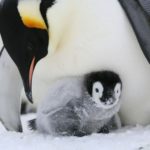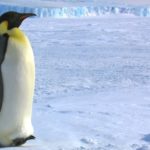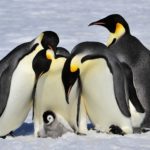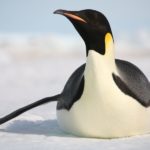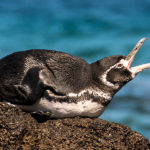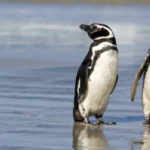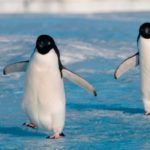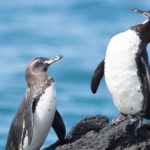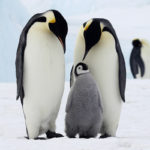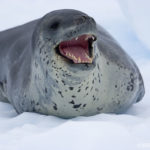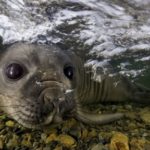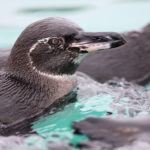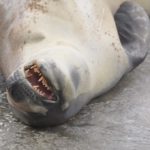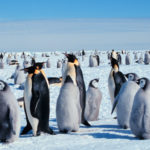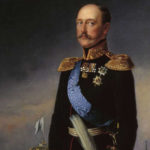Emperor penguin – Description, lifestyle and habits
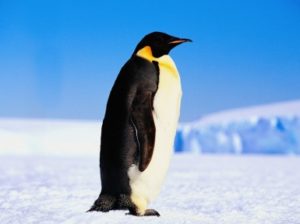 The Emperor Penguin is the largest of all penguins, weighing up to 45 kilograms and growing under 1.20 meters. It has colorful feathers around the neck and head, while the head itself and the back of the body are black, and the abdominal part is white.
The Emperor Penguin is the largest of all penguins, weighing up to 45 kilograms and growing under 1.20 meters. It has colorful feathers around the neck and head, while the head itself and the back of the body are black, and the abdominal part is white.
While the king penguin is a subantarctic species and is scattered throughout the continent, the emperor is a resident of the deep South. The view was discovered by the Bellingshausen expedition in 1819-1822.
In many ways, emperor penguins are no different from their smaller counterparts, just like the others, they feed on fish, squid and krill, which they catch, but diving deep behind them, where no other penguin can dive. ? Like other penguins, they have the ability to jump out of the water. This is what they do when they escape from predators.
It is the emperor penguin that has unique features that distinguish it not only from other penguins, but also from all animals in general. And above all, this is an increased ability to store oxygen in the body and the ability to withstand high pressure under water. In a calm state, the number of heartbeats, per minute, is 60-70. Before diving, it increases to 200 strokes, and already under water the number of strokes drops to the level of 20 strokes, with a good supply of oxygen. After returning to land, the number again increases to 200 strokes in order to fully restore the body and breathe in plenty.
The body of the emperor penguin is covered with feathers resembling a long scale. To maintain heat, there is a very thick fat layer under the skin. The body of the penguin is very heavy. It does not have air bags under the skin, there are also layers of air under the feather, and the penguin’s bones are quite heavy. Heavy weight facilitates the process of diving for prey. He gets his food only under water. Penguins are masters of diving, here they surpass almost all birds and are not inferior to dolphins and seals in their skills. Sometimes near the shore or at shallow depths there is a lot of penguin food, and then they have absolutely no need to dive deep. But if necessary, he can dive under the water for several tens of meters and stay there a couple of minutes.
Emperor penguins breed in the midst of the Antarctic winter and only on sea ice. This cycle begins, usually in late April to May. Penguins lay their eggs where it is possible for the chicken to take shelter from the wind in the future, for example between ice and icebergs, as it can be carried by the wind. Eggs are laid in May-June, weighing about 0.4 kg. Like all penguins, the male is responsible for the egg, which covers the future chicken with a special fold on its stomach to maintain the desired temperature. The males sit huddled together to keep their heat to the maximum, because the air temperature can reach -50 degrees Celsius. This is quite unusual, because adult males are very aggressive and territorial.
Penguins are hard at hatching eggs! During this exhausting winter season, the birds lose weight, because they practically do not eat, because they do not hunt, the plumage is polluted, it becomes dull and disheveled.
As a rule, parents help each other to litter chicks, guarding the eggs in turn – one hunts, the other “works as a nanny”. There are also selfish penguins who, having given an egg, go away to hunt and simply do not return until the chicks appear. In this case, the second parent, exhausted from hunger, may try to go hunting with an egg and lose it. This is a great sorrow. Sometimes in such cases, unfortunate birds try to steal an egg from an adjacent masonry.
On average, hatching occurs within 110 days. During this time, the penguin loses 40% of its body weight. They sleep for almost the entire period of incubation in order to preserve their reserves, because if you leave an egg not for a long time, it can die. Mother leaves the sea and returns only in July, usually her return coincides with the hatching of the chicken. Then the male leaves for the sea. There he restores lost energy and fat. A chicken is raised in the most common way. Parents take turns watching him and feed him until he is big enough to leave.
